Key Takeaways
- Overall Best Time: Spring (September-November) and autumn (March-May) offer pleasant weather nationwide
- Patagonia: December-February provides ideal access to hiking trails and attractions
- Buenos Aires: March-May and September-November offer mild temperatures with fewer tourists
- Iguazu Falls: April-June or August-September combine good weather with moderate crowds and impressive water volume
- Budget Travel: June-August (except ski resorts) offer lower prices nationwide
Table of Contents
Introduction
Argentina stretches across nearly 2,200 miles from the subtropical north to the subantarctic south, encompassing diverse landscapes from the mighty Andes to the vast Pampas plains. This geographical diversity creates a complex patchwork of climates and seasonal patterns that can make planning the perfect trip challenging.
When is the best time to visit Argentina? The honest answer is: it depends on what you want to see and do. Unlike smaller countries with consistent climates, the optimal timing for an Argentine adventure varies dramatically depending on whether you’re exploring the glaciers of Patagonia, the vineyards of Mendoza, or the steamy rainforests surrounding Iguazu Falls.
This comprehensive guide breaks down Argentina’s seasons by region, activity, and interest to help you plan the perfect trip according to your priorities. From peak hiking conditions in Patagonia to optimal wine tasting in Mendoza, we’ll cover everything you need to know about timing your Argentine adventure. “best time to visit argentina”
Understanding Argentina’s Climate & Geography
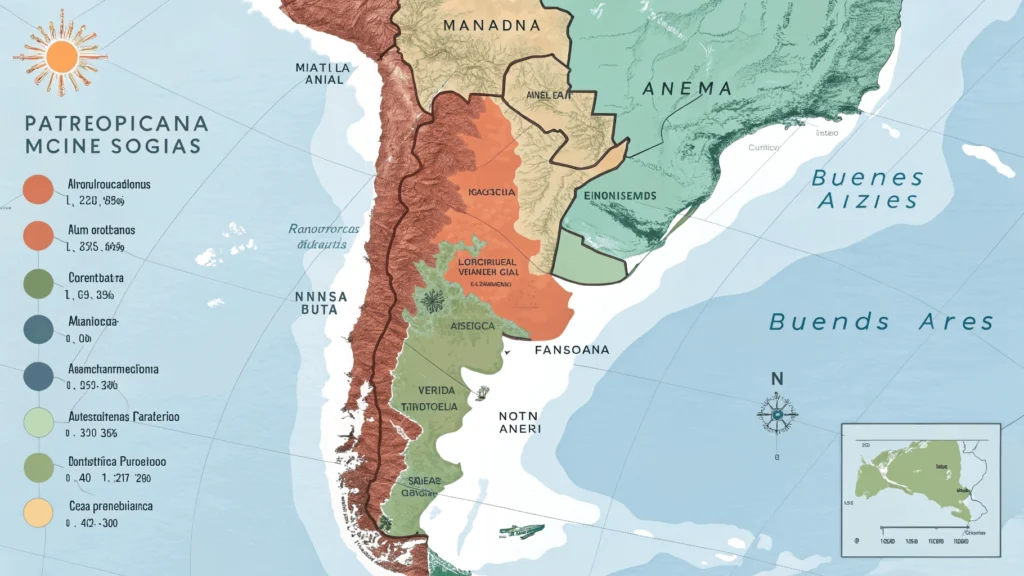
Before diving into specific recommendations, it’s essential to understand Argentina’s geographical layout and how it influences the country’s diverse climate patterns. “best time to visit argentina”
Argentina spans multiple climate zones due to its vast north-south extension and varying elevations. The country can be divided into several major regions:
- Patagonia: The southernmost region featuring dramatic mountains, glaciers, and steppes
- Andes/Mendoza: The western mountainous region known for vineyards and skiing
- Pampas/Buenos Aires: The central plains and coastal capital region
- North/Iguazu: The subtropical northeastern zone where the famous falls are located
- Northwest: Arid highlands and colorful mountains near the Bolivian border
As Argentina is in the Southern Hemisphere, the seasons are reversed compared to North America and Europe: For more details on Argentina’s climate classification and regional weather zones, refer to the World Bank Climate Knowledge Portal for Argentina.
- Summer: December to February
- Autumn: March to May
- Winter: June to August
- Spring: September to November
Altitude and latitude both play crucial roles in determining local climate conditions. For example, the high-altitude Northwest experiences significant temperature drops at night even during summer months, while Buenos Aires maintains relative humidity year-round due to its coastal location. “best time to visit argentina”
Overall best time to visit argentina
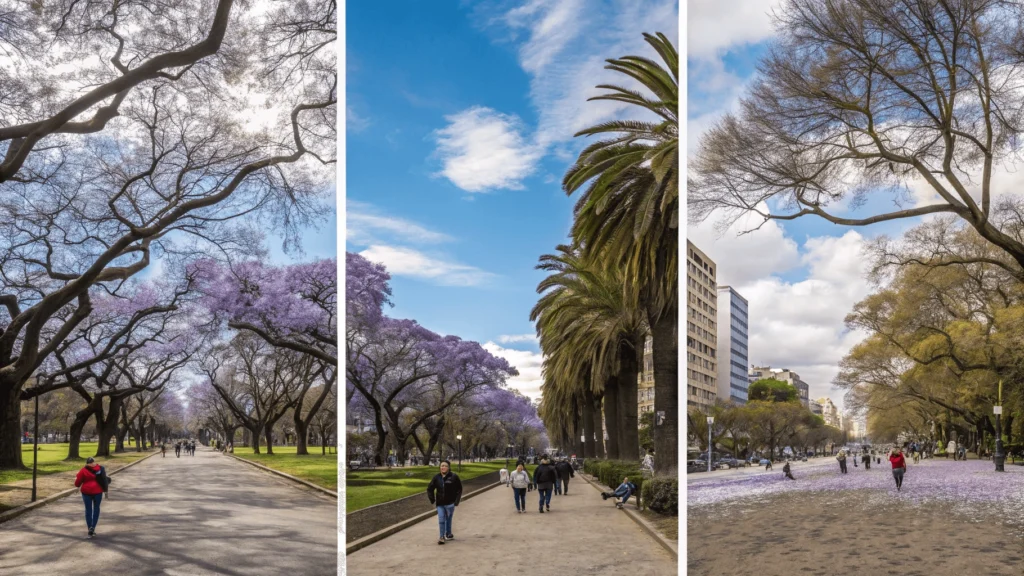
Shoulder Seasons (Spring: Sep-Nov, Autumn: Mar-May)
The shoulder seasons offer the best overall balance for exploring multiple regions of Argentina:
Advantages:
- Mild, pleasant temperatures in most regions
- Fewer tourists and lower prices than peak season
- Beautiful spring blooms (September-November) or autumn foliage (March-May)
- Most attractions and hiking trails are open and accessible
Spring (September-November) brings blooming landscapes, with October particularly delightful for Buenos Aires and wine regions. Patagonia begins to open up with early spring wildflowers by late October, though some high-altitude trails may still have snow.
Autumn (March-May) offers harvest celebrations in wine country, stunning fall colors in Patagonian forests, and comfortable temperatures nationwide. April is often considered a “perfect month” for multi-region itineraries. “best time to visit argentina”
Peak Season (Summer: Dec-Feb)
Advantages:
- Optimal weather for Patagonia hiking and exploration
- Longest daylight hours (up to 17 hours in southern Patagonia)
- Lively atmosphere in popular tourist destinations
- All attractions and routes fully accessible
Disadvantages:
- Significantly higher prices for accommodation and activities
- Crowded popular sites, especially in Patagonia and Iguazu
- Advance bookings essential (3-6 months) for quality lodging
- Can be uncomfortably hot in northern regions and Buenos Aires
Low Season (Winter: Jun-Aug)
Advantages:
- Excellent skiing in the Andes resorts near Mendoza and Bariloche
- Significantly lower prices in most regions (except ski destinations)
- Buenos Aires offers a cozy, cultural experience with fewer tourists
- Wildlife viewing opportunities for southern right whales in Peninsula Valdes
Disadvantages:
- Many Patagonian services reduced or closed
- Shorter daylight hours limit sightseeing time
- Cold and potentially snowy conditions in southern regions
- Some remote roads may be impassable
Deep Dive: Best Time by Region
Patagonia
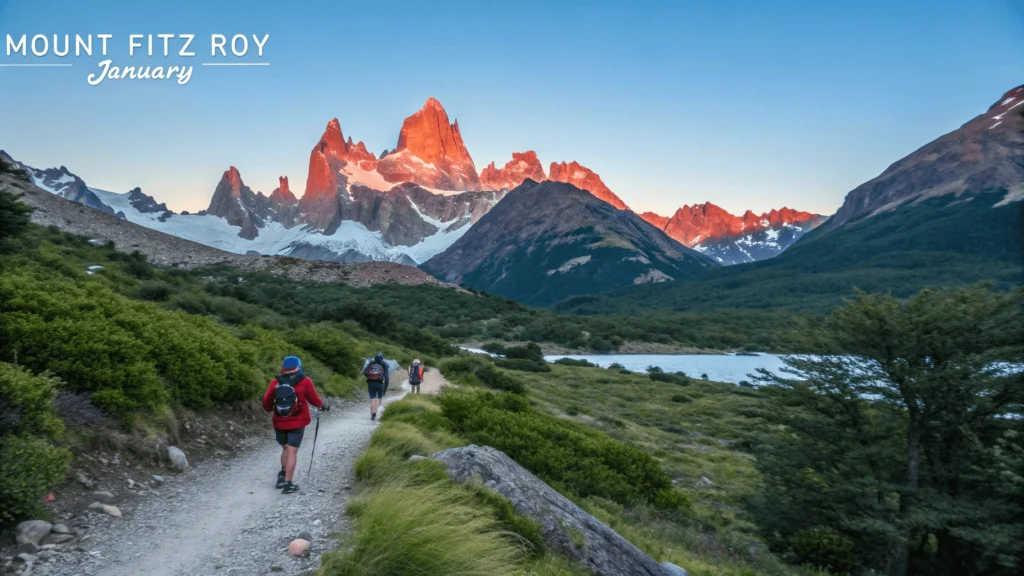
Patagonia’s extreme southern location makes its climate particularly seasonal, with the region effectively closed to most visitors during winter. “best time to visit argentina”
Spring (Sep-Nov)
- Weather: Temperatures gradually warming from 40-55°F (4-13°C), windy conditions common
- Activities: Early spring hiking, wildlife viewing, fewer crowds
- Pros: Increasing daylight, spring wildflowers, lower prices
- Cons: Some trails still snow-covered until late October, unpredictable weather
- Key Sights: Torres del Paine (Chile side accessible earlier), El Calafate, Ushuaia
Summer (Dec-Feb)
- Weather: Peak conditions, 50-70°F (10-21°C), strong winds still present
- Activities: Hiking, kayaking, glacier trekking, full range of excursions
- Pros: Maximum trail access, longest daylight hours, reliable transportation
- Cons: Very crowded popular trails, advance booking essential, peak prices
- Key Sights: Mount Fitz Roy treks, Perito Moreno Glacier, Peninsula Valdes, full Torres del Paine circuit
- To plan hikes in Patagonia’s national parks, including updated trail conditions and closures, visit the Administración de Parques Nacionales (Argentina National Parks Service).
Autumn (Mar-May)
- Weather: Cooling temperatures, 45-60°F (7-16°C), decreasing winds
- Activities: Hiking, photography, wildlife viewing
- Pros: Spectacular fall colors, decreasing crowds after Easter
- Cons: Services begin scaling back in May, shortening days
- Key Sights: Tierra del Fuego National Park, Los Glaciares National Park, Lake District
Winter (Jun-Aug)
- Weather: Cold and potentially harsh, 30-45°F (-1-7°C), limited daylight
- Activities: Limited to winter sports, photography, urban exploration
- Pros: Dramatic snowy landscapes, virtually no crowds
- Cons: Many lodgings and restaurants closed, limited transportation options
- Key Sights: Skiing near Ushuaia, Bariloche ski resorts, limited urban excursions
Buenos Aires

The cosmopolitan capital enjoys a temperate climate with humid, hot summers and mild winters.
Spring (Sep-Nov) “best time to visit argentina”
- Weather: Pleasant warming trend, 60-75°F (15-24°C)
- Activities: Cultural events, outdoor dining, park explorations
- Pros: Jacaranda trees blooming in November, comfortable temperatures, Learn more about jacaranda season and city parks in Buenos Aires at the Buenos Aires City Government’s tourism site.
- Cons: Some spring showers, increasing tourist numbers by November
- Key Sights: San Telmo Market, Recoleta Cemetery, Palermo gardens in bloom
Summer (Dec-Feb) “best time to visit argentina”
- Weather: Hot and humid, 75-90°F (24-32°C)
- Activities: City beaches, nightlife, cultural events
- Pros: Vibrant street life, outdoor milongas (tango venues), extended hours
- Cons: Uncomfortably hot and humid, many locals leave in January
- Key Sights: Puerto Madero waterfront, evening cultural events, weekend markets
Autumn (Mar-May) “best time to visit argentina”
- Weather: Gradually cooling, 55-75°F (13-24°C)
- Activities: Walking tours, cultural events, café culture
- Pros: Ideal temperatures, cultural calendar in full swing
- Cons: Increasing chance of rain, especially in April
- Key Sights: Teatro Colón performances, museums, La Boca neighborhood
Winter (Jun-Aug) “best time to visit argentina”
- Weather: Mild winters, 45-60°F (7-16°C)
- Activities: Indoor cultural experiences, shopping, gastronomy
- Pros: Fewer tourists, no need for advance reservations
- Cons: Occasional cold snaps, shorter days
- Key Sights: MALBA museum, indoor shopping galleries, tango shows
Iguazu Falls “best time to visit argentina”
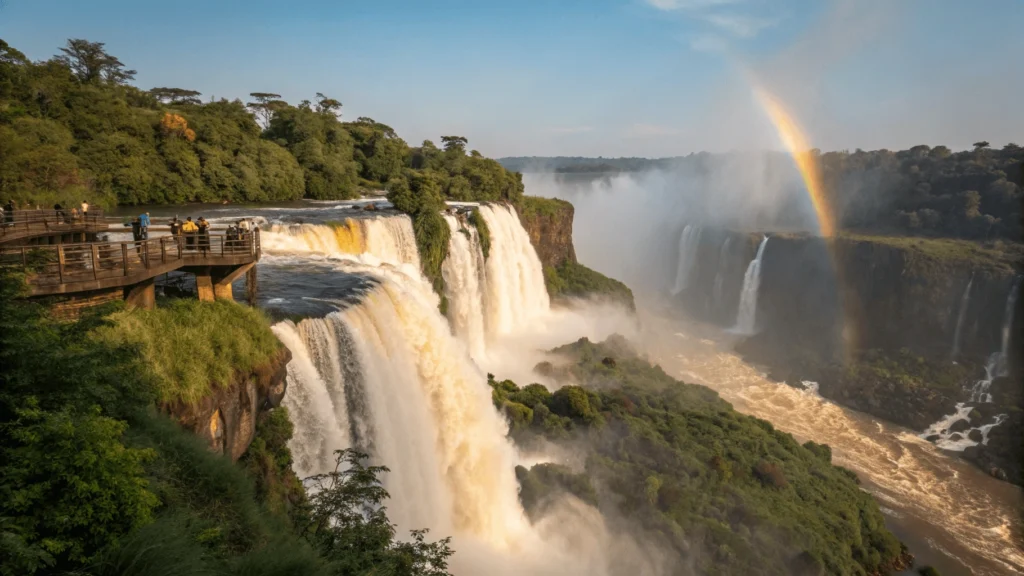
The subtropical climate around Iguazu Falls means it’s accessible year-round, but with distinct advantages to certain seasons. You can explore visitor guidelines, trail maps, and current conditions at Iguazú National Park (Parque Nacional Iguazú). “best time to visit argentina”
Spring (Sep-Nov)
- Weather: Warming temperatures, 65-85°F (18-29°C), moderate rainfall
- Activities: Falls viewing, jungle treks, boat rides
- Pros: Increasing water volume after winter dry season, good wildlife viewing
- Cons: Increasing tourist numbers, occasional heavy downpours
- Key Sights: Devil’s Throat, Upper and Lower Circuits
Summer (Dec-Feb)
- Weather: Hot and humid, 75-95°F (24-35°C), frequent rain
- Activities: Falls viewing, jungle exploration, water activities
- Pros: Lush vegetation, maximum water volume
- Cons: Peak crowds, uncomfortable humidity, insects
- Key Sights: San Martin Island, Macuco Trail, boat excursions
Autumn (Mar-May)
- Weather: Gradually moderating, 60-80°F (16-27°C), decreasing rainfall
- Activities: Falls viewing, bird watching, photography
- Pros: Good balance of water volume and clear days, fewer crowds after Easter
- Cons: Unpredictable rainfall patterns, still warm
- Key Sights: Bird Park, helicopter tours, both Argentinian and Brazilian sides
Winter (Jun-Aug)
- Weather: Mild and drier, 55-75°F (13-24°C), occasional cold fronts
- Activities: Falls viewing, jungle walks, photography
- Pros: Lowest humidity, fewer insects, clearer views
- Cons: Potentially lower water volume during prolonged dry periods
- Key Sights: Full moon tours, longer hikes, wildlife spotting
Mendoza Wine Region
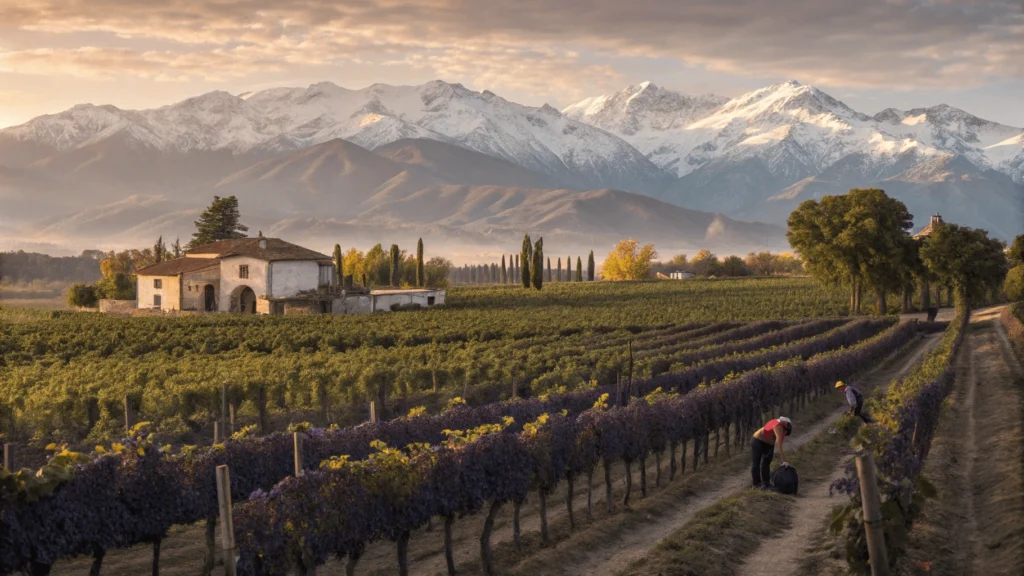
Mendoza’s semi-arid climate and location in the rain shadow of the Andes creates ideal conditions for viticulture and year-round visits. “best time to visit argentina”
Spring (Sep-Nov)
- Weather: Warming and pleasant, 60-80°F (16-27°C)
- Activities: Vineyard tours, mountain excursions, biking
- Pros: Vine flowering, green landscapes, fewer tourists
- Cons: Some wineries still preparing for high season
- Key Sights: Luján de Cuyo wineries, Aconcagua views, city parks
Summer (Dec-Feb)
- Weather: Hot and dry, 75-90°F (24-32°C)
- Activities: Winery visits, outdoor dining, mountain activities
- Pros: Vibrant atmosphere, grape growing season, outdoor events
- Cons: Hot midday temperatures, busier wineries, higher prices
- Key Sights: Uco Valley premium wineries, outdoor concerts, thermal spas
Autumn (Mar-May)
- Weather: Cooling and ideal, 55-75°F (13-24°C)
- Activities: Harvest celebrations, wine tasting, culinary experiences
- Pros: Vendimia festival (early March), harvest activities, autumn colors
- Cons: Busy period at wineries, advance reservations needed
- Key Sights: Harvest events, Maipú wine route, autumn vineyard colors
Winter (Jun-Aug)
- Weather: Cool and dry, 40-65°F (4-18°C), cold nights
- Activities: Wine tasting, skiing, thermal springs
- Pros: Snow-capped mountain views, cozy cellar experiences, few tourists
- Cons: Some high-altitude vineyards may have limited access
- Key Sights: Las Leñas ski resort, intimate winery tours, city exploration
Northwest Andes

This high-altitude region offers dramatic landscapes and indigenous culture, with significant temperature variations between day and night. Learn about the region’s UNESCO-designated sites like Quebrada de Humahuaca on UNESCO’s official page. “best time to visit argentina”
Spring (Sep-Nov)
- Weather: Dry and moderate, 65-80°F (18-27°C) days, cool nights
- Activities: Cultural exploration, photography, hiking
- Pros: Clear skies, comfortable daytime temperatures, fewer tourists
- Cons: Strong UV radiation, dusty conditions
- Key Sights: Quebrada de Humahuaca, Salinas Grandes, Purmamarca
Summer (Dec-Feb)
- Weather: Warm days, 70-85°F (21-29°C), afternoon rain common
- Activities: High-altitude hikes, cultural experiences, photography
- Pros: Lush landscapes after rain, local festivals
- Cons: Afternoon thunderstorms can interrupt activities, some roads affected
- Key Sights: Cachi, Cafayate wine region, Tafí del Valle
Autumn (Mar-May)
- Weather: Cooling temperatures, 60-75°F (16-24°C), decreasing rainfall
- Activities: Hiking, wine tasting in Cafayate, photography
- Pros: Clear mountain views, pleasant temperatures, harvest season
- Cons: Increasing chance of colder nights, especially in May
- Key Sights: Quebrada de las Conchas, Colomé vineyard, indigenous markets
Winter (Jun-Aug)
- Weather: Clear and dry, 55-70°F (13-21°C) days, potentially freezing nights
- Activities: Photography, cultural experiences, wine tasting
- Pros: Exceptional visibility, dramatic landscapes, few other tourists
- Cons: Very cold nights (possibly below freezing), reduced local activities
- Key Sights: Salta city exploration, Calchaquí Valleys, architectural sites
Deep Dive: Best Time by Activity/Interest
Hiking & Trekking
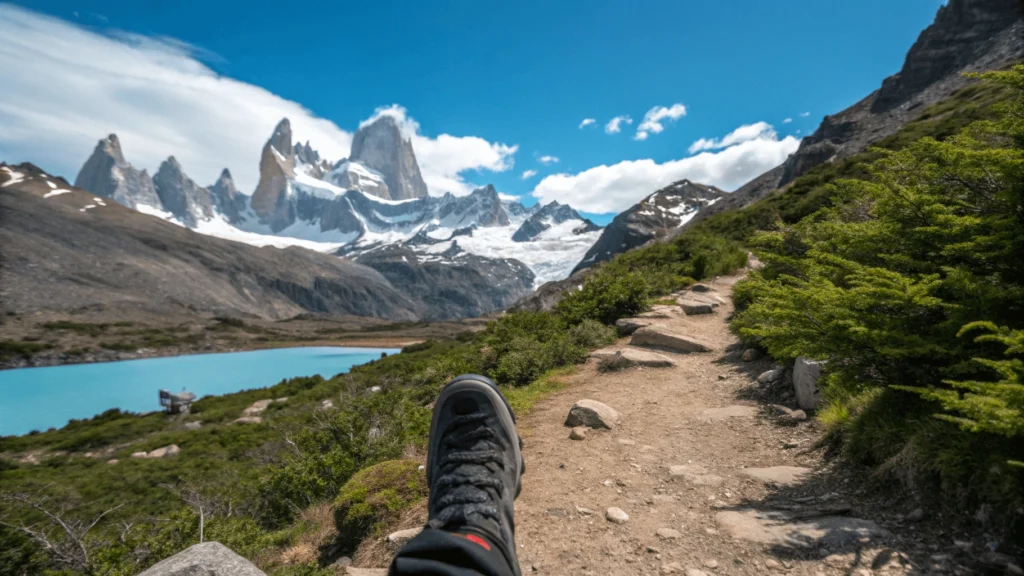
Optimal Period: November to early April
The peak hiking season in Patagonia runs from December through February, when trails are fully accessible and weather is most stable. Early November and March-April offer fewer crowds with generally good conditions, though weather becomes more unpredictable.”best time to visit argentina”
Key Information:
- Most popular trails (Mount Fitz Roy, Torres del Paine) are extremely busy in January
- Book refugios (mountain huts) 6+ months in advance for high season
- Trail conditions are best from late November through March
- Some high passes may retain snow until December
- Weather remains highly variable even in summer – always prepare for sudden changes
City Exploration
Optimal Period: March-May and September-November
Argentina’s major cities, particularly Buenos Aires, are best explored during the temperate seasons of autumn and spring when temperatures are pleasant for walking tours and outdoor cafés.”best time to visit argentina”
Key Information:
- Buenos Aires is best in April-May and October-November
- January can be uncomfortably hot and many locals leave the city
- Winter (June-August) offers lower hotel rates and fewer tourists
- Spring brings jacaranda blooms to Buenos Aires (November)
- Cultural calendars are fullest during March-June and August-November
Iguazu Falls Visit
Optimal Period: March-April and August-September
The falls are accessible year-round, but the best experience balances water volume with clear weather and manageable crowds.
Key Information:
- Water volume is highest during rainy season (December-February)
- Clearest views typically come during winter dry season (June-August)
- March-April offers a good balance of impressive volume and decreasing crowds
- August-September provides increasing flow with still-reasonable visitor numbers
- Devil’s Throat platform can close briefly during extremely high water periods
Wildlife Viewing “best time to visit argentina”
Optimal Period: Varies by species and location
Argentina offers diverse wildlife viewing opportunities with different optimal timing:
Key Information:
- Peninsula Valdes whales: June-December (peak September-October)
- Peninsula Valdes elephant seals: October-April
- Peninsula Valdes penguin colonies: September-April, The Global Penguin Society offers research-based information on Magellanic penguins and their conservation in Patagonia.
- Iberá Wetlands birds and caimans: Best year-round, exceptional September-November
- Andean condors: Visible year-round, best viewing in clear winter months
Skiing/Winter Sports
Optimal Period: July-September
Argentina’s ski season typically runs from mid-June through early October, with July and August offering the most reliable snow conditions. “best time to visit argentina”
Key Information:
- Las Leñas (Mendoza Province): Best advanced terrain, July-August optimal
- Cerro Catedral (Bariloche): Largest resort, peak conditions late July-August, Check snow reports and resort status at Catedral Alta Patagonia’s official website (in Spanish).
- Chapelco (San Martín de los Andes): Family-friendly, reliable August snow
- July school holidays (mid-July to early August) bring domestic crowds
- August generally offers the deepest snowpack
- Late season (September) can provide spring skiing conditions with fewer crowds
Cultural Events & Festivals
Argentina’s calendar is filled with vibrant cultural events. Plan your visit around these highlights:
- February: Carnival celebrations nationwide
- Early March: Vendimia Wine Harvest Festival (Mendoza), UNESCO recognizes Mendoza’s winemaking heritage as part of the Creative Cities Network, celebrating its cultural and culinary significance.
- April: Buenos Aires International Book Fair
- May: Gaucho traditions at the Rural Society Exhibition
- June: Buenos Aires Tango Festival (two weeks)
- July: Independence Day celebrations (July 9)
- August: World Tango Championships in Buenos Aires
- October: Traditional Chamamé music festivals in Corrientes
- November: Jazz festivals in Buenos Aires
- December: Summer music festivals begin nationwide
Budget Travel “best time to visit argentina”
Cheapest Months: May-June and August-September (excluding ski resorts)
For budget-conscious travelers, the shoulder months between high and low seasons offer the best value:
Key Information:
- Low season (May-September, excluding ski areas) offers 30-40% accommodation discounts
- Avoid December-February nationwide for budget travel
- Easter week is exceptionally expensive throughout Argentina
- May and late August/September offer excellent value-to-weather ratio
- Consider package deals for Patagonia in October or April
- Buenos Aires offers consistent budget options year-round in certain neighborhoods
Avoiding Crowds
Least Crowded Periods: May and September-October (varies by region)
To experience Argentina’s highlights with minimal crowds:
Key Information: “best time to visit argentina”
- Patagonia: April and October offer good conditions with significantly fewer visitors
- Buenos Aires: June-August sees fewer tourists (though comfortable for city exploration)
- Iguazu Falls: May and September combine decent weather with lower visitor numbers
- Wine Regions: April-May (post-harvest) and June offer less crowded experiences
- Always avoid Argentine school holidays (summer: December-February, winter: two weeks in July)
Practical Planning Factors
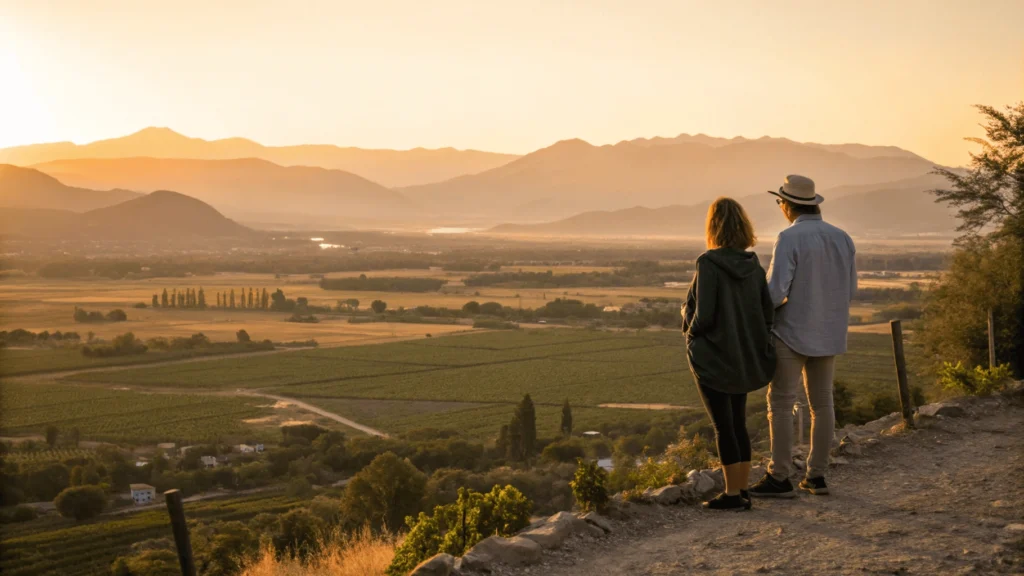
Month-by-Month Summary Table
| Month | Best Regions | Weather Highlights | Major Events | Crowd/Price Level |
|---|---|---|---|---|
| January | Patagonia, Atlantic Coast | Hot in north, ideal in south | Beach festivals | High |
| February | Patagonia, Beaches | Hot and humid in north | Carnival celebrations | High |
| March | Mendoza, Patagonia | Cooling in north, mild in south | Vendimia Festival (Mendoza) | Medium-High |
| April | Nationwide | Pleasant autumn | Easter celebrations | Medium |
| May | Northwest, Buenos Aires | Cooling, fall colors | Rural exhibitions | Low-Medium |
| June | Northwest, Mendoza | Dry, cold nights | Wine festivals | Low |
| July | Ski resorts, Iguazu | Cold in south, mild in north | Independence Day (July 9) | Medium |
| August | Iguazu, Ski resorts | Dry nationwide | Tango Championships | Medium |
| September | Buenos Aires, Northwest | Spring begins, variable | Student Day | Low-Medium |
| October | Nationwide | Spring flowers, warming | Rural exhibitions | Medium |
| November | Buenos Aires, Lake District | Warming, jacaranda blooms | Jazz festivals | Medium-High |
| December | Patagonia, Lake District | Hot in north, warm in south | Summer festivals begin | High |
Crowds vs. Weather vs. Price
The traveler’s eternal triangle in Argentina: “best time to visit argentina”
Peak Season (December-February)
- Best weather for Patagonia and southern attractions
- Highest prices nationwide (30-50% premium)
- Maximum crowds at major attractions
- Essential to book 3-6 months in advance
Shoulder Seasons (March-May, September-November)
- Good weather in most regions
- Moderate prices (15-20% below peak)
- Manageable crowds at major attractions
- Booking 1-2 months ahead usually sufficient
Low Season (June-August, excluding ski areas)
- Mixed weather (ideal in north, challenging in far south)
- Lowest prices (30-40% below peak)
- Minimal crowds except at ski resorts
- Limited availability in remote Patagonia
Argentinian Public Holidays
Major holidays that impact travel plans:
- New Year’s Day: January 1
- Carnival: February/March (moveable, Monday and Tuesday before Ash Wednesday)
- Easter: March/April (moveable, Thursday-Sunday)
- Labor Day: May 1
- May Revolution: May 25
- Independence Day: July 9
- San Martín Day: Third Monday in August
- Columbus Day: October 12
- Immaculate Conception: December 8
- Christmas: December 24-25
During these periods, domestic tourism increases, prices rise, and advance booking becomes essential. Transportation systems may be overloaded, and some businesses close for extended holidays, particularly between Christmas and New Year.”best time to visit argentina”
How to Choose Your Ideal Time
Selecting the best time for your Argentina trip depends primarily on your priorities:
If Patagonia hiking is your priority: Plan for December-March, with January-February offering optimal conditions but maximum crowds. Early December and late March provide a good balance of conditions and crowds.”best time to visit argentina”
If budget is key: May and late August/September offer the best value-to-experience ratio across most of the country (avoiding ski resorts in winter).
If you want to experience multiple regions: April and October typically offer the best compromise for experiencing diverse regions in good conditions.”best time to visit argentina”
If you’re focused on wildlife: September-November provides the best overall wildlife viewing opportunities, particularly in Patagonia and Peninsula Valdes.
If wine experiences are central: February-April coincides with harvest activities and celebrations, with March being the absolute peak for wine enthusiasts.”best time to visit argentina”
If you prefer fewer tourists: May and September are the sweet spots for experiencing Argentina without crowds while still enjoying reasonable weather.

Conclusion
Argentina’s vast geographical diversity means there’s no single “perfect” time to visit the entire country. The best time truly depends on your specific interests, budget considerations, and the regions you wish to explore. “best time to visit argentina”
For most travelers seeking to experience multiple regions, the shoulder seasons of March-April and October-November offer the best overall balance of weather conditions, crowd levels, and value. These periods allow you to explore both the northern and southern extremes of this magnificent country without the peak crowds or prices.
Before finalizing your plans, check the specific forecasts for your intended destinations and consider how flexible your itinerary can be. Argentina rewards adaptable travelers who can adjust their plans according to regional conditions and seasonal advantages. “best time to visit argentina”
Whatever time you choose to visit, Argentina’s stunning landscapes, passionate culture, and unforgettable experiences will make for an extraordinary journey through one of South America’s most diverse and captivating countries.


